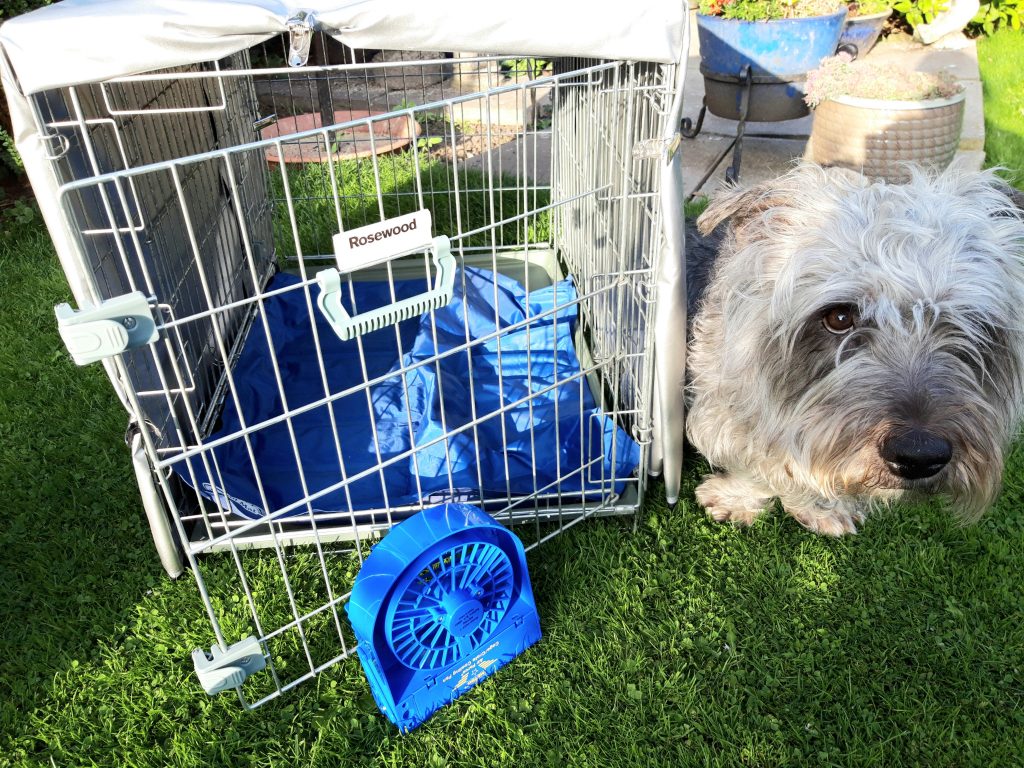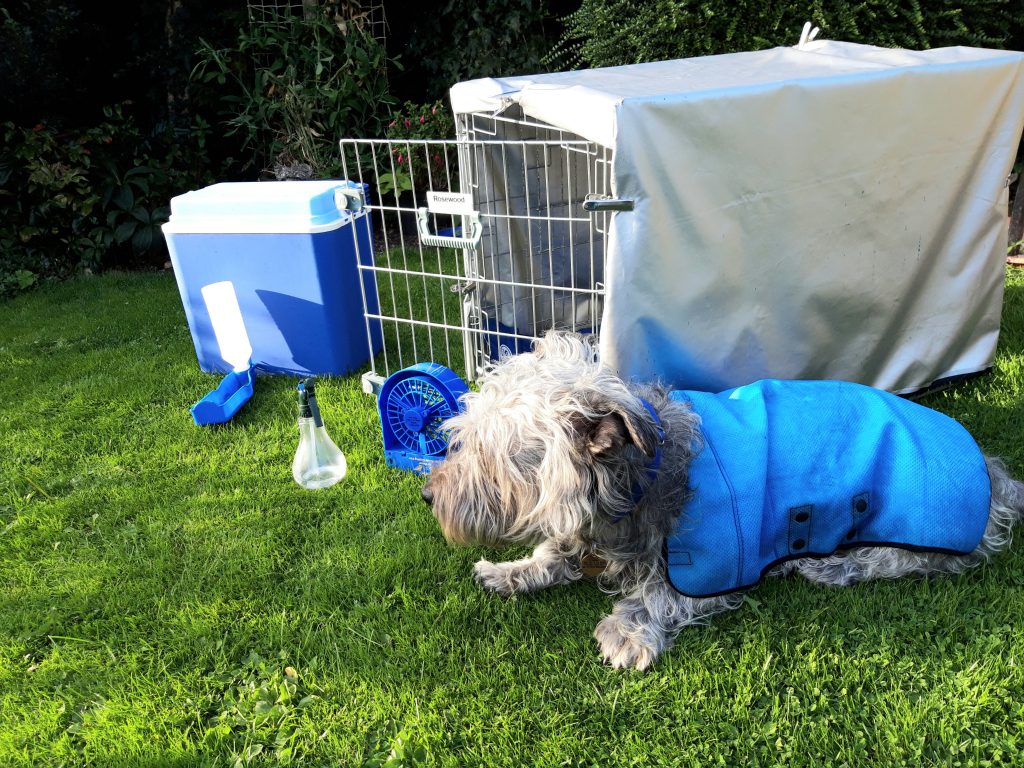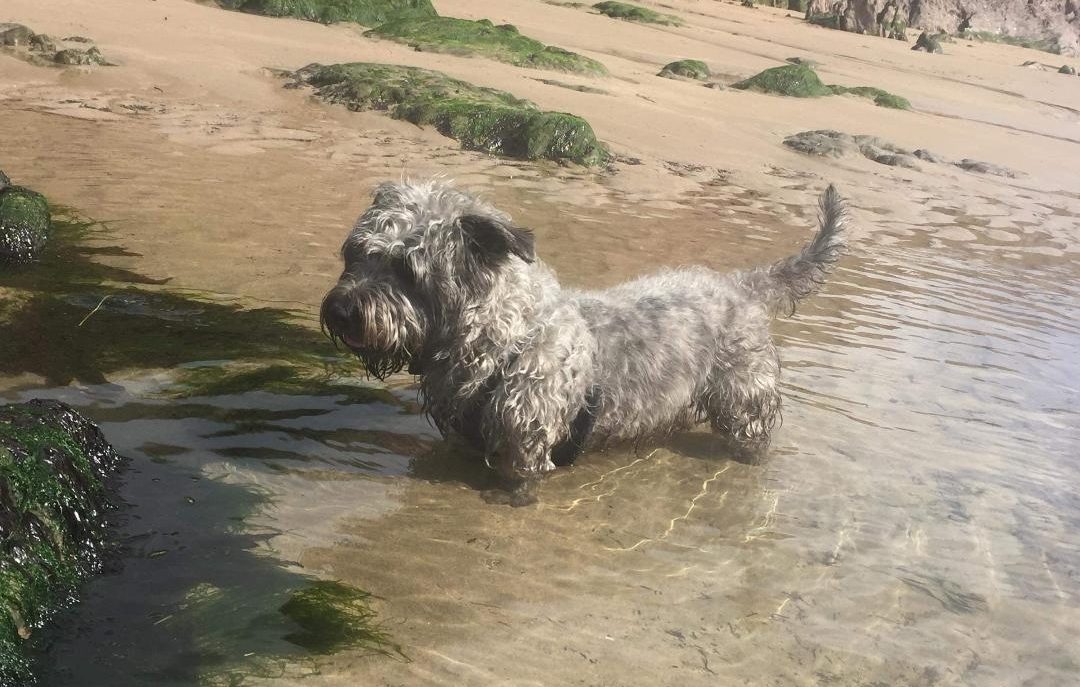Out and About in Hot Weather
During very hot weather, I keep the house as cool as possible and walk my dogs early in the morning and later in the evening. If I have to travel with my dogs, I like to be prepared with my heatwave kit.
Some questions that need to be asked:
- Is my journey really necessary? Can I travel earlier/later?
- How long will it take and could there be traffic hold ups?
- Am I able to stop regularly to check that my dogs are OK?
- Do I have Air Conditioning in my car and is it working?
- Do I have tinted windows or full size shades, also at the rear?
- Do I know the signs of dehydration and what to do?
- What do I need to take with me to prevent/treat dehydration?
If I am happy to proceed with my journey, and having made sure I have put sufficient cool blocks in the freezer the day before, I fill at least two large plastic containers with water (2 litre milk ones are ideal) and put them in a large cool bag with the blocks. Next I get a towel for each dog, soak them in cold water, wring them out and add them to the cool bag.
Crate fans are ideal for when the car is stationary so the batteries should be checked in advance. Foil sheeting is another useful cooling aid so pegs will be needed to attach it to crates to reflect back the sun. I pack the wetted cool blue dog coats and similar blue sheet and fill a handy spray bottle to moisten them again as they soon dry out in hot weather. I don’t forget the large umbrella, just the right size sunshade for a Glen.

Finally I check there’s a water bowl, not forgetting the small handy bottle with dish attached to use ringside if it was a show day. On hot show days I would remain in the tented benching area until shortly before the start of our breed judging. We then waited in the shade if possible, blue cool coat on the dog sitting under the umbrella waiting for his class and small water bottle to hand. Just before his class was called, the coat was whipped off so that he could relax in the ring with the cool blue sheet draped over him until his turn to be judged. The sheet would then go round my neck as I handled my dog.
A good way to check for dehydration is the skin test. On a cool day lift some skin and check how long it takes to spring back. On a dehydrated dog it will take longer to spring back. Probably the first sign of dehydration is drooling. Dogs cannot sweat so they try to cool themselves down by panting along with excessive drooling as the condition worsens. He will appear lethargic with bloodshot eyes.
Remember that dogs cool themselves from their paws upwards. Standing in the hot sun on the pavement is the worst case scenario for your dog. If you cannot bear to place your hand on the pavement for more than five seconds and your dog is showing signs of distress, then it’s time to remove your dog and take steps to cool him down immediately. Waiting under the shade of a tree in tremendous heat does not keep your dog sufficiently cool so it’s important to observe him closely for signs of distress.
If you need to take action, stand him on a cold wet towel and spray his tummy with cold water. It is already a serious situation if he is panting excessively. DO NOT, HOWEVER WORRIED YOU MAY BE, turn a hosepipe on your dog or dunk him in a cold bath, the village trough or nearby pond as his internal organs will expand with shock and he might die as a result.

If you have a spare crate tray to hand, fill it with 1 cm of cold water ONLY and stand your dog in it until he has recovered. Blue Glens will attract the sun more, also young and older dogs are more vulnerable to heat.
I’ve suffered in heatwaves since childhood so it ‘goes down the lead’. In hot weather, as well as the sun hat, sun glasses, cold drink and sun blocker, I need a cold flannel to put on the base of my neck because, unlike dogs, we humans cool down quickly on this part of our anatomy!
It’s worth searching on line for up-to-date canine cooling products like the ones I have mentioned. Fans can be also purchased from camping and caravan outlets.
Another problem can be melting bitumen caused by hot pavements and roads. I believe one of the best ways of removing bitumen / tar / thick oil from pads is baby oil or other oils which are harmless if ingested, should your dog try to lick it off. It will take some time, so patience is the key. Remember the pads on a dog are like a brush so work the oil from front to back otherwise you will work the contaminant in further!
Ann Quinn 2016
Updated and published in the 2020 GOITA Summer Newsletter
